No you didn’t misread the title, it really is “in the Arctic”, not the attic!
Introduction
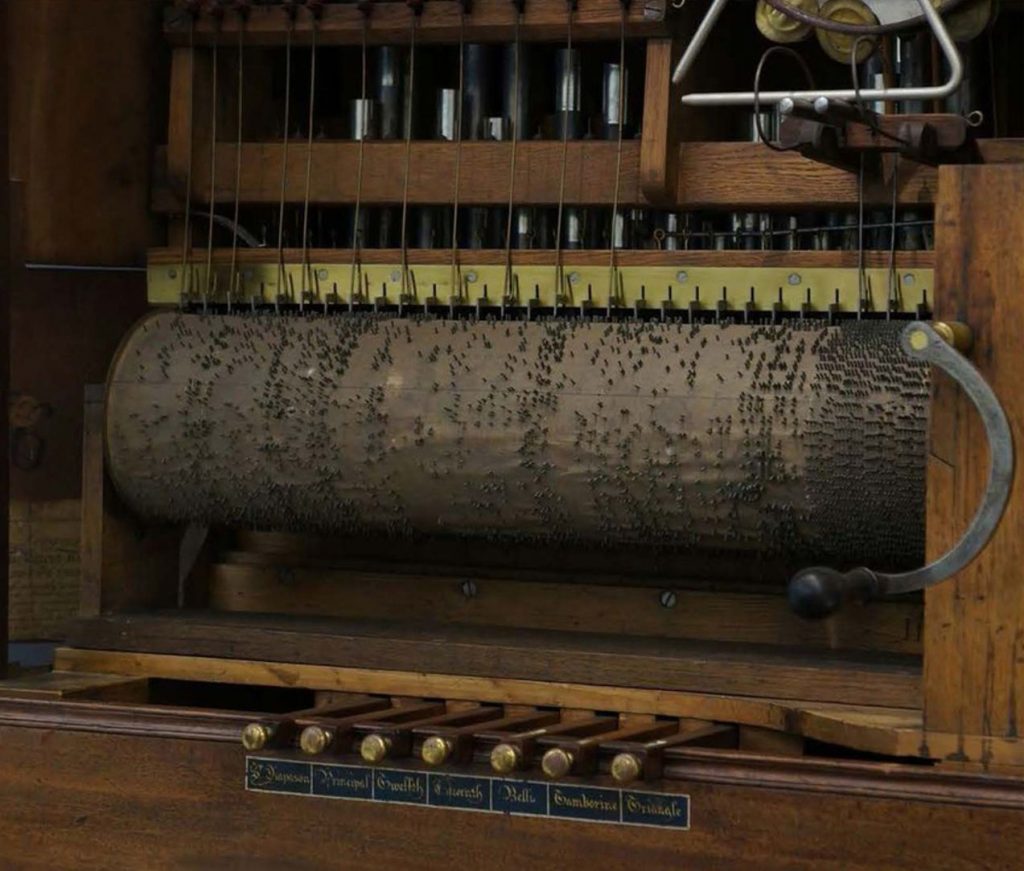 In 1819, Lieutenant William Edward Parry was in charge of an expedition which made a (literal) breakthrough in the search for a North-West passage from the Atlantic to the Pacific. Parry was bold enough to carry on past the point at which his predecessor, John Ross, had turned back, and after 10 months in which his two ships, Hecla and Griper, were stranded by frozen ice, they found a route out. How they passed the time in those long dark days has fascinated me, in particular the idea that he took a mechanical musical instrument, a chamber barrel organ, on board with him.
In 1819, Lieutenant William Edward Parry was in charge of an expedition which made a (literal) breakthrough in the search for a North-West passage from the Atlantic to the Pacific. Parry was bold enough to carry on past the point at which his predecessor, John Ross, had turned back, and after 10 months in which his two ships, Hecla and Griper, were stranded by frozen ice, they found a route out. How they passed the time in those long dark days has fascinated me, in particular the idea that he took a mechanical musical instrument, a chamber barrel organ, on board with him.

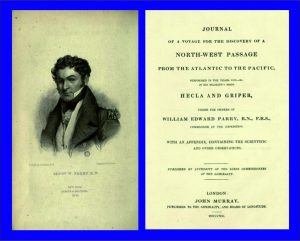 On returning from this first trip Parry was promoted to Commander and subsequently made two further voyages to the Arctic in 1821-23 and 1824-25, and also made an attempt on the North Pole in 1827 which remained the record for the next 49 years. He was knighted in 1829 and eventually attained the rank of Rear-Admiral in the Royal Navy. To find out more about his explorations and achievements, Wikipedia will give you the bare facts, any number of books can fill it out for you, and his journals are also online.
On returning from this first trip Parry was promoted to Commander and subsequently made two further voyages to the Arctic in 1821-23 and 1824-25, and also made an attempt on the North Pole in 1827 which remained the record for the next 49 years. He was knighted in 1829 and eventually attained the rank of Rear-Admiral in the Royal Navy. To find out more about his explorations and achievements, Wikipedia will give you the bare facts, any number of books can fill it out for you, and his journals are also online.
I shall concentrate on the musical aspects of these journeys.
Please note: Although this is a long post, it is just the tip of the iceberg of a massive amount of original research. Anyone wishing to cite this original research should credit it to Katie Howson and cite this website as the source.
Why take a mechanical musical instrument to the Arctic?
From various entries in Parry’s journals, it is clear that the barrel organ earned its place on the ship from the first voyage onwards …
In December 1819, when the Hecla and Griper were icebound in a natural harbour just off the coast of Melville Island, Parry wrote that, when the weather permitted, he sent the crew out to walk on the shore in the mornings and: “When the day was too inclement for them to take this exercise, they were ordered to run round and round the deck, keeping step to the tune of an organ, or, not unfrequently, to a song of their own singing,”
On the second voyage, in 1821, Parry noted: that the crews of the two ships came together for a religious service, when “ some psalm tunes, which had been purposely set upon an organ, were played at the proper intervals …”
Although the ships were icebound, the men were not entirely isolated, as they met some of the Inuit people (“Esquimaux” in the terminology of the time) living nearby, and it appears that the local women in particular were fond of singing, music and dancing, as several journal entries indicate.
In January 1822: “On our reaching the ships, these people expressed much less surprise and curiosity than might naturally have been expected on their first visit, which may, perhaps, in some measure, be attributed to their being in reality a less noisy kind of people than most of the Esquimaux to whom we had before been accustomed. Quiet and orderly, however, as they were disposed to be, this first visit showed them to be as fond of merriment as their countrymen are usually considered ; for, on Captain Lyon’s ordering his fiddler up on the Hecla’s deck, they danced with the men for an hour, and then returned in high glee and good-humour to their huts.”
“On the 4th a number of Esquimaux came to the ships, and […] were then taken on board, and derived great amusement from our organ, and from anything in …the shape of music, singing, or dancing, of all which they are remarkably fond.
“On the 7th I paid another visit to the huts, where I found scarcely anybody but women and children, the whole of the men, with the exception of the two oldest, having gone on a sealing excursion to the northeastern side of the island. One of the women, named Iligliuk, a sister of the lad Toolooak, who favoured us with a song, struck us as having a remarkably soft voice, an excellent ear, and a great fondness for singing, for there was scarcely any stopping her when she had once begun.”
“On the 8th we were visited by a musical party of females, consisting only of a few individuals expressly invited for this purpose. A number of the officers assembled in the cabin to hear this vocal concert, while Mr. Henderson and myself took down the notes of their songs, for which, indeed, they gave us every opportunity, for I thought they would never leave off. We afterward amused them with our little band of flutes and violins, and also by some songs, with the whole of which they were extremely well pleased.”
“On the morning of the 12th […] It was enough, however, with Iligliuk, just to make the motion of turning the handle of the organ, which, conveying to her mind the idea of music and merriment, was always sure to put her immediately into high spirits.”
“John Longman’s New Invented Patent Barrel Organ with bells, drum and triangle”, which produced such merriment, is now housed in the Scott Polar Research Institute in Cambridge.
Other onboard entertainment
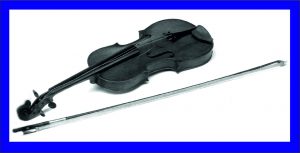 The explorers weren’t totally reliant on mechanical music, as several of the officers on the various voyages were known to be musical, including Parry himself, whose violin is on display in the Maritime Museum in Greenwich.
The explorers weren’t totally reliant on mechanical music, as several of the officers on the various voyages were known to be musical, including Parry himself, whose violin is on display in the Maritime Museum in Greenwich.
Parry noted in December 1819: “the men were permitted to amuse themselves as they pleased, and games of various kinds, as well as dancing and singing occasionally, went on upon the lower deck till nine o’clock, when they went to bed […] It is scarcely necessary to add, that the evening occupations of the officers were of a more rational kind than those which engaged the attention of the men. Of these, reading and writing were the principal employments, to which were occasionally added a game of chess, or a tune on the flute or violin, till half past ten, about which time we all retired to rest.”
Parry also describes the publication of a weekly satirical magazine and a series of theatrical entertainments which: “… took place regularly once a fortnight, and continued to prove a source of infinite amusement to the men. Our stock of plays was so scanty, consisting of one or two odd volumes, which happened accidentally to be on board, that it was with difficulty we could find the means of varying the performances sufficiently ; our authors, therefore, set to work, and produced, as a Christmas piece, a musical entertainment, expressly adapted to our audience, and having such a reference to the service on which we were engaged, and the success we had so far experienced, as at once to afford a high degree of present recreation, and to stimulate, if possible, the sanguine hopes which were entertained by all on board, of the complete accomplishment of our enterprise.”
The Scott Polar Research Institute has in its catalogue: “The New Georgia Gazette & Winter Chronicle” – Playbill (1): “Theatre Royal, New Georgia. On Friday next the 5th November 1819 will be performed Garrick’s celebrated farce of “Miss in her Teens”. Cast list (all male). Playbill (2): (no heading) “The North West Passage, or Voyage Finished” (cast list all male).”
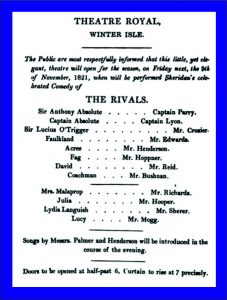 The cast list for The Rivals shown here is from the second voyage, and indicates that men took the women’s parts. Costumes were taken on board specifically for use in theatrical productions and replenished by a donation from the ladies of Bath, Parry’s home town, at one point. After the first voyage, the newspaper idea was dropped, but they then had a Magic Lantern on board for visual as well as musical entertainment – it’s amazing what they found room for on those ships!
The cast list for The Rivals shown here is from the second voyage, and indicates that men took the women’s parts. Costumes were taken on board specifically for use in theatrical productions and replenished by a donation from the ladies of Bath, Parry’s home town, at one point. After the first voyage, the newspaper idea was dropped, but they then had a Magic Lantern on board for visual as well as musical entertainment – it’s amazing what they found room for on those ships!
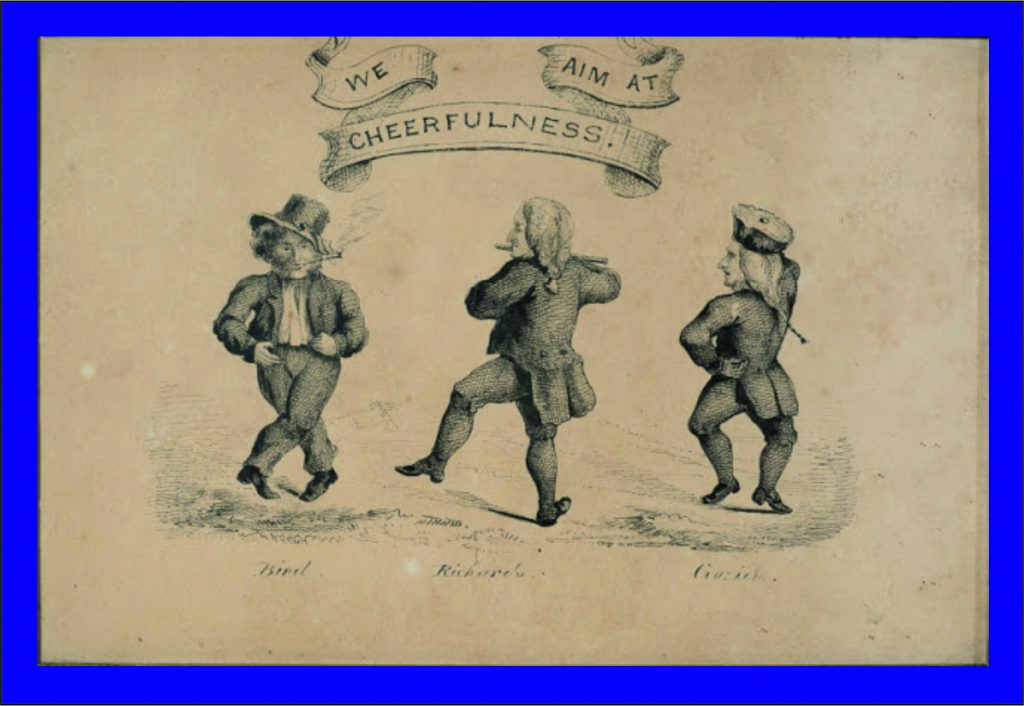
By the third voyage Parry and his colleagues felt the need to vary the entertainments slightly, and a series of masquerade balls were held. The drawing above, by the otherwise unknown C. Staub, is dated 2nd February 1825 and shows Charles Richards playing the flute while Edward Bird (left) and Francis Crozier (right) dance. In this illustration they do not appear to be doing a conventional social dance, and are more likely to be doing some sort of step dance – yes, possibly the Sailor’s Hornpipe, but all sorts of individual stepdances existed at the time. The article Esther Gayton part 2: ‘Miss Gayton’s Hornpipe’ gives more details of this type of dance.
According to Regina Koellner’s article Edward Parry and the Birth of the Arctic Thespians, the idea was for “officers and men being able to participate on equal terms, where everything could be worn from a simple domino (which was the minimum costume to be admitted) to an elaborate fancy dress and everybody could decide freely how much he wanted to participate.” In 1821, in his record of the second voyage, Captain George Lyon noted: “Those ‘ladies’ who had cherished the growth of their beards and whiskers, as a defence against the inclemency of the climate, now generously agreed to do away with such unfeminine ornaments, and everything bode fair for a most stylish theatre.”
Some men would also have taken the ladies’ positions in the social dances of the day that went with the jigs, reels and strathspeys on the barrel organ, except when the Inuit women came on board and danced with them.
John Longman’s New Invented Patent Barrel Organ with bells, drum and triangle
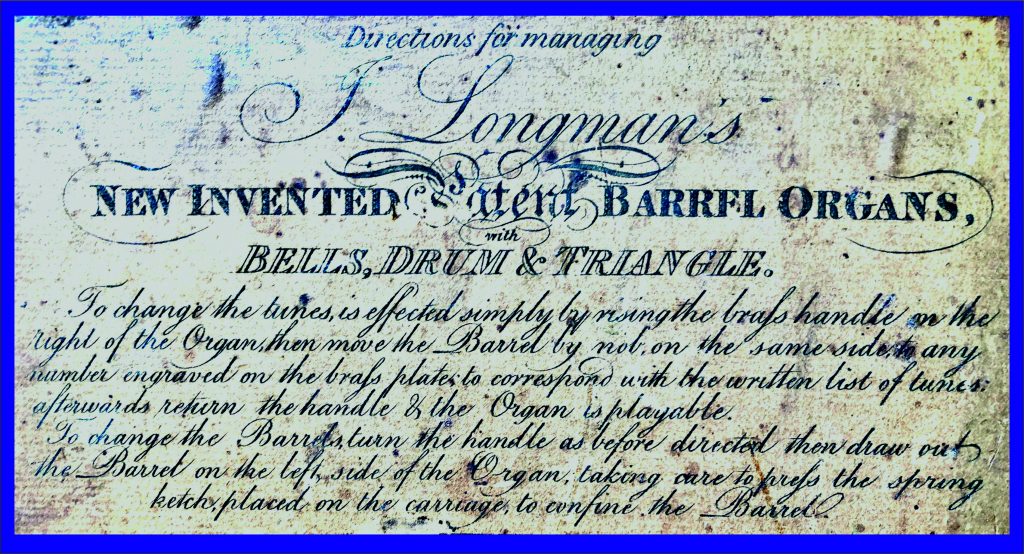
The barrel organ that Parry bought was made by the well-respected firm of John Longman between 1801 and 1816. The various generations of Longmans entered into several business relationships (Broderip, Clementi etc) and was based in the centre of the music publishing business at the time, Cheapside in London. They published sheet music as well as making and selling instruments. The Horniman Museum and the Bate Collection have a number of clarinets, flutes and oboes made by the firm, and several of their barrel organs and pianos are still in existence, some in private hands and some in museums.
Developing new and improved systems of producing mechanical music was big business in this period, with several companies arguing over who had invented what. This type of chamber barrel organ was made for private entertainments, and newspaper advertisements of the time make it clear that it was the equivalent of the gramophone or the Dansette in the twentieth century – it provided dance music without the need for live music.
Newspaper adverts also indicate that Longman’s considered both their pianos and barrel organs to be able to withstand extreme heat, as mentioned in this 1802 advert:
“Longman and Co.’s new invented Patent Barrel Organs, with Bells, Drums and other Accompaniments (being the only Patent granted for ten years past), constructed on entire new principles, warranted to keep in order, and resist the hottest climates; additional barrels may be made without any pattern, and the very defective and inconvenient method of changing the Tunes by Notch pins entirely exploded.”
They were probably not the only makers looking at the colonial market, as the second advert here shows a barrel organ of unknown for private sale in the Calcutta Gazette of 25th June 1812.
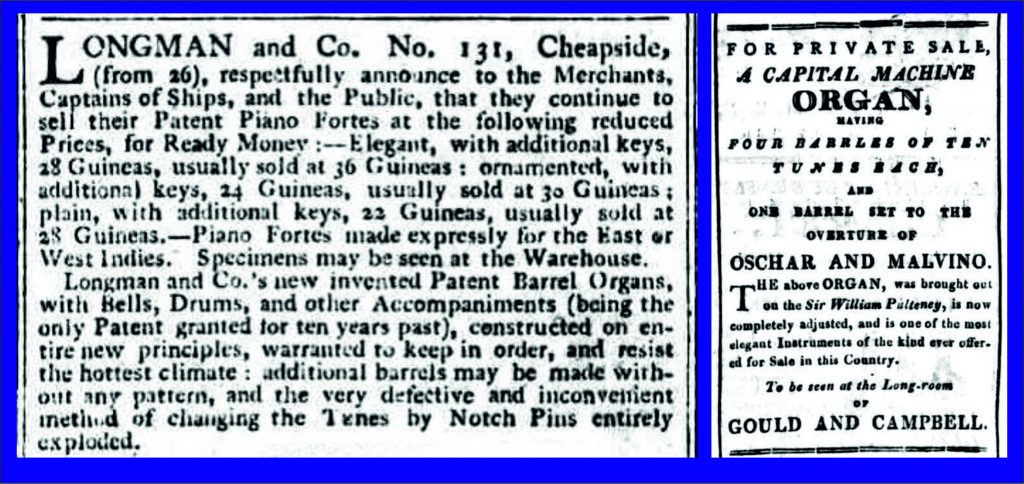
Michael Kassler, in his examination of Longman’s instrument-making business in The Music Trade in Georgian England describes how, as well as taking instruments overseas for their own personal use, captains and other officers would sometimes buy pianos and barrel organs in London to sell off in foreign ports, and Longman’s offered a generous discount to those doing so.
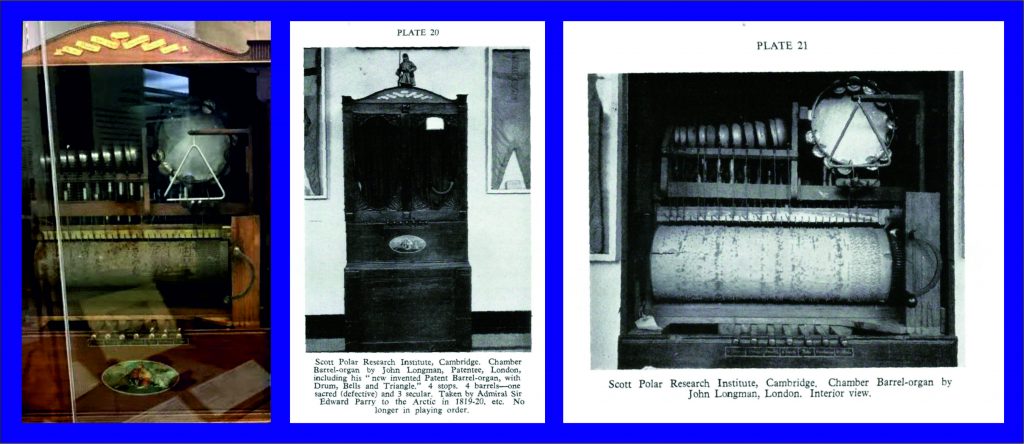
The photographs above are of Parry’s Longman barrel organ (a) in situ in the Scott Polar Research Institute in 2016; (b) in the SPRI in the 1960s, prior to restoration; (c) interior view from the same date showing bells, tambourine (“drum”) and triangle with seven stops below the barrel. Confusingly, the 1960s photo says it has four barrels including one of sacred songs, whereas it is now known to have five.
The SPRI describes the instrument: “A hand-operated barrel organ with five cylindrical music barrels comprising eight tunes on each. The speed of play can be varied by the rate at which the handle is turned. The sound can be altered with the use of seven turned brass-handled stops on the front of the organ case, which allow the user to select which sets of bells and percussion instruments are included in the play cycle. The sound is produced through a series of 11 white metal cloche bells, a triangle and a tambourine. The instruments, barrels, and wooden and brass mechanical operating mechanism are built into a free-standing wooden cabinet with Neo-Classical carved fluting on the rectangular uprights and surrounds of the red textile-lined door cartouches. The double doors can be opened with a lock at the top of the cabinet to reveal the mechanism and to allow for replacement of the barrel. Printed instructions and handwritten song list has been pasted inside one of the doors. A painted roundel depicting the Royal coat of arms is below the stops on the cabinet exterior, and a gilded scroll with patent inscription is at the top of the cabinet frame.”
Parry’s barrel organ lay neglected and inoperative for nearly 150 years until it was donated by Parry’s great-grandson to the Scott Polar Research Institute in 1954 when an initial restoration was carried out by Canon A.O. Wintle and J.D. Budgen, followed in the early 1970s by a full restoration by Clive Holland and Fred Hill, a music teacher and watch and clock repairer who was a distinguished member of the Musical Box Society of Great Britain. The restoration was key to recordings being made and issued on an LP on the Saydisc label in 1972. This album (still available on CD) included all 8 religious items, God Save the King and 24 of the original 31 dance tunes.
Both the Musical Box Society and the Scott Polar Research Institute have been very helpful in providing obscure pieces of information, and quite recently the SPRI sent me the full playlist for this barrel organ, so I have been able to look at the entire repertoire contained on the five barrels. Typically these playlists were written by hand and pasted inside the cabinet of the organ, and the contents seem to have varied from instrument to instrument, whether at the behest of the owner or the maker isn’t known. Longman’s were also prolific music publishers so they may have tied in the barrel organ repertoire with their most popular publications.
The music on this barrel organ
Barrel 2 contains 8 hymns and psalms, and God Save the King is on Barrel 4, but all the other 31 tunes are dance tunes.
Dancing was an incredibly popular pastime in that period for people of all classes, mostly done by couples in a longways formation, and tunes for the dances proliferated with the expansion of printing, being the equivalent of buying recorded music in the twentieth century.
The tunes on the barrel organ are absolutely typical of the period, including English and Scottish reels, with just two jigs, both with distinctly Irish sounding names: Paddy Carey, which is a staple of the English session repertoire these days, and Paddy O’Rafferty, a well-known tune in the Irish repertoire, which is the subject of Will the real Paddy O’Rafferty please stand up! Most of the tunes would have been “pop songs” of the time – popular dance tunes and a few songs, with one mystery item, which may be the subject of a future article – if I can find out a bit more!
Click here to see the Parry barrel organ complete listing. Some of the tunes were not able to be identified at the time the recording was made. As I have not been able to listen to all of the six unidentified tunes on Barrel 5 (the names are illegible due to the list from Barrel 2 having been pasted over the top) I can’t put them in the correct order. There were only five un-named tunes on the LP/CD, which are all now identified, but there is one more on the original Barrel. One of the tunes unidentified at the tme of the recording – is Miss Gayton’s Hornpipe; see Esther Gayton part 2: ‘Miss Gayton’s Hornpipe’.
On the LP, each tune is played through twice, which lasts for about one minute. The longways dances of the day would take longer than that, and although I’m not experienced in the practicalities of playing tunes on repeat, I understand this is quite possible. This barrel organ has seven stops, which can alter the instrumentation of the piece, and the speed is controlled by how fast the operator turns the handle.
In a great piece of good luck, someone contacted me last year with photos of the “twin” to this barrel organ, which is in North Carolina, and I have included a photo here as it is shows the “furniture” aspect of the instrument more clearly than those I have of Parry’s own barrel organ.
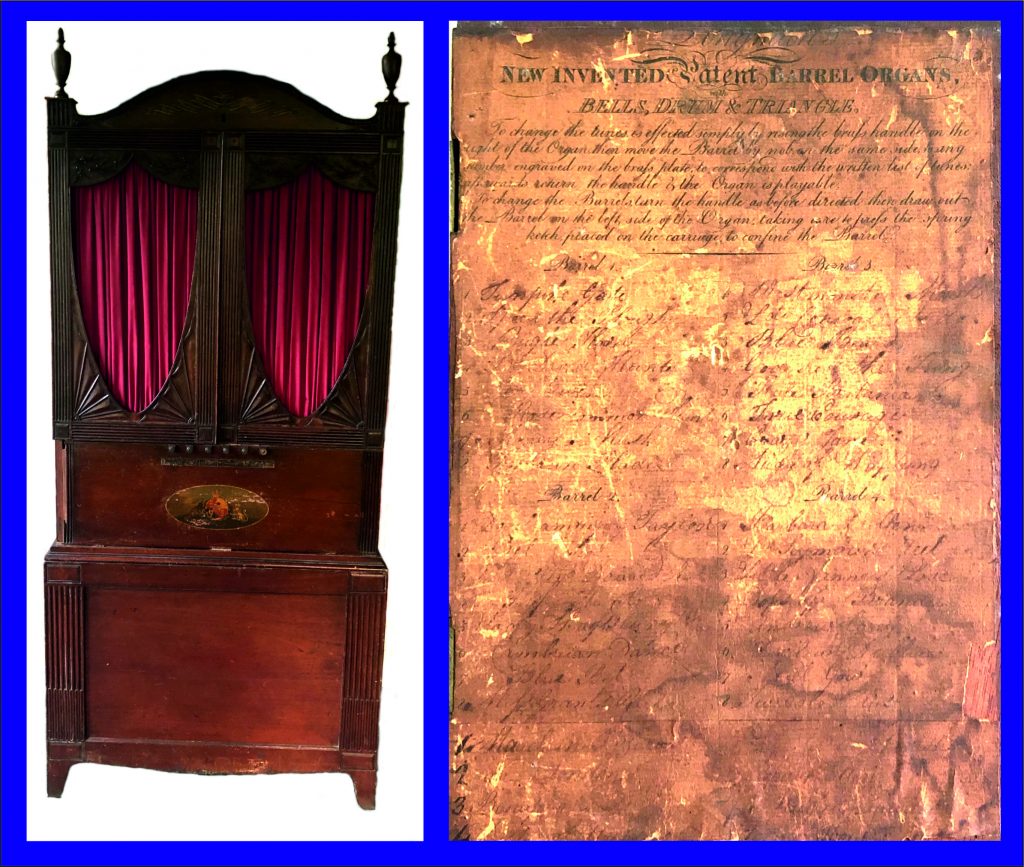 Also shown is the handwritten playlist from no. 40, which is mostly illegible, but out of 40 items on the 5 barrels that were originally with the organ (now all lost) less than half can be identified and one barrel ( 8 items) appears to be all patriotic. The others seem to be all dance tunes with only two being included on the Parry instrument (the ubiquitous Devil Amongst the Tailors and Speed the Plough). There is also, unusually, a song, the well-known folksong Barbara Allen which has quite a slow and sad melody.
Also shown is the handwritten playlist from no. 40, which is mostly illegible, but out of 40 items on the 5 barrels that were originally with the organ (now all lost) less than half can be identified and one barrel ( 8 items) appears to be all patriotic. The others seem to be all dance tunes with only two being included on the Parry instrument (the ubiquitous Devil Amongst the Tailors and Speed the Plough). There is also, unusually, a song, the well-known folksong Barbara Allen which has quite a slow and sad melody.
The strength of the barrel organ seems to lie in upbeat dance tunes, rousing patriotic anthems and stirring hymns, which are the more typical contents of the other playlists I have studied for comparison.
Afterword
There has been some real excitement recently around the idea that these mechanical instruments actually preserve musical performance styles from earlier periods, with contemporary decorations and embellishments which are not always evident from written scores. As Arthur Ord-Hume put it in a long article in The Music Box in 2013, “The programmers […] are those artistic craftsmen who could take a musical score with all its wide-open interpretational imperfections and from it create a genuinely brilliant performance via the process of translating the music into the pins and staples of the barrel or cylinder that formed the musical playlist for these instruments.”
That is a really fascinating concept, and the quality of the musical arrangement pinned on a barrel must be a result of the level of musicianship of the programmer, as well as of his/her craft skills. But Ord-Hume and subsequent researchers into this area such as Emily Baines, seem to be more interested in the classical pieces written by Handel, Haydn etc, expressly for barrel organs, whereas, I (as ever) am more interested in the popular culture represented by the dance tunes – and of course, in the people who made the instruments, bought and sold them, pricked out the music onto the barrels, carried them on board the ships, danced and marched and sang to the tunes on them.
I like to imagine the musicians on board (including Parry) getting these tunes stuck in their heads – what we call an “ear worm” these days – and getting home after a long voyage to find these tunes coming out from their fingers after having heard them so frequently in the long dark icebound days. A bit more fanciful is to imagine the Inuit women who were so attracted by this music taking the melodies back to their homes and handing them on to later generations who took up the accordion and created their own traditions using this European instrument …
See also Will the Real Paddy O’Rafferty please stand up! and Esther Gayton part 2: Miss Gayton’s Hornpipe (forthcoming).
The 1972 Saydisc LP Parry’s Barrel Organ is still available on CD by mail order, and at the time of writing the whole album is also available to listen to on this YouTube link.
Parry’s barrel organ is housed in the Scott Polar Research Institute in Cambridge. My thanks to them for their remote support during lockdowns.
Most of Parry’s journals and other contemporaneous material is digitised and may be viewed and downloaded by searching for “Captain William Edward Parry” on the Hathi Trust website.
You can read some marvellous stories about the entertainments on board Parry’s Arctic fleet on Regina Koellner’s 2016 blog about the life and times of Francis Crozier in her article Edward Parry and the Birth of the Arctic Thespians.
Much useful information about the dances and music of the period is on the Regency Dances website, where Paul Cooper’s research papers are published. Paul has been a huge support to all my research on the Parry barrel organ and its music.
Heather Clarke’s website Colonial Dance has several articles relating to dancing and music at sea. She has investigated the musical and dancing side of John Franklin, another Arctic explorer in the 1820s, who on sailing to Australia in 1836 took his treasured piano with him on board the Fairlie, where it was brought up on deck for his niece to play for country dancing and quadrilles.
The Musical Box Society of Great Britain has been very helpful and interested in this project, and they have a great online archive of back numbers of their journal, The Music Box on their rather quirky website. Arthur Ord-Hume’s article referred to above is entitled Learning from Interpretations by Mechanical Instruments and was originally presented on 7th July 2013 at the first Conference on Mechanical Music in London. The full article can be found online in The Music Box Volume 26, no. 5, Spring 2014.
A very brief report on the restoration of the barrel organ by Fred Hill and Clive Holland is online.
The photo of Parry’s violin is taken from Music of the Sea, by David Proctor, National Maritime Museum, 1995 and revised edition, 2005 – I recommend both editions, which can be bought at reasonable prices second-hand. I’ve also found The Music Trade in Georgian England, by Michael Kassler, Routledge, 2016 (first published by Ashgate in 2011) to be invaluable, with an impressive range of primary sources. It’s expensive but snippets can be viewed online.
The colour photo of Parry’s barrel organ is by Regina Koellner and the two mono ones come from the book Church and Chamber Barrel-Organs by Langewill & Boston. Mine is the second edition from 1970, before the major restoration of the instrument.
The newspaper advertisement for Longman’s pianofortes and barrel organs is from The London Courier and Evening Gazette, Monday 15th February 1802, and the advertisement for a private sale is from the Calcutta Gazette, 25th June 1812.
The portrait of Parry and the engraving The Crews of H.M.S. Hecla & Griper Cutting into Winter Harbour, Sept. 26th, 1819 are from Parry’s journals.
The drawing of the dancing midshipmen by C. Staub came from Regina Koellner’s blog and the original is owned by the Royal Geographical Society. The cast list for The Rivals also came from the same source.
Thanks to Ron Mack in North Carolina for the photos and information about the Longman no. 40. barrel organ.
Last but absolutely not least, thanks to dancer and researcher Simon Harmer for the inspiration on these stories!
Please note: Anyone wishing to cite this original research should credit it to Katie Howson and cite this website as the source. © Katie Howson, 2021.
I have carried out a lot of careful research into this specific barrel organ, comparable ones in both museums and private hands, the music on them and much more – I have far too much information to publish here. Please do get in contact if this is a special area of interest or study to you, I would be happy to tell you more.
Leave a Reply